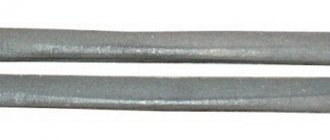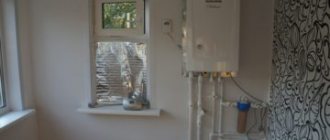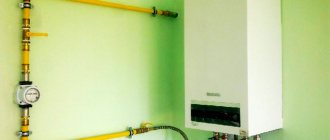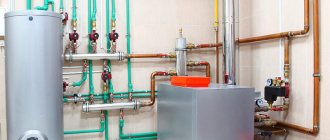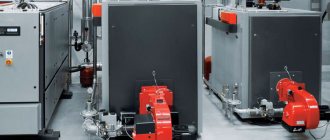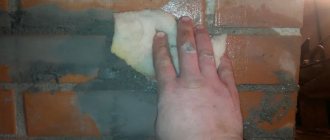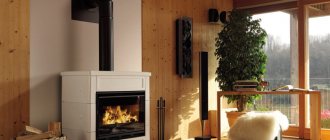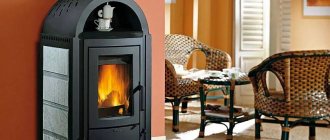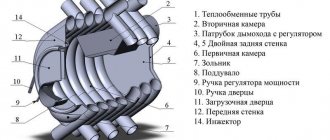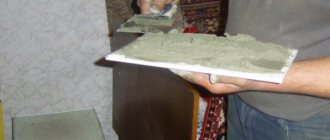| INSTALLATION OF ANY STOVES AND FIREPLACES We will install any stove, fireplace, cladding or chimney. Finishing the fireplace with stone. | WARRANTY FOR ALL TYPES OF WORK We are responsible for the quality of work performed and materials. You will receive a one-year installation warranty. | SAFE INSTALLATION All work is carried out strictly in compliance with safety standards. We use only non-flammable safe materials. |
Choosing the optimal location
To select, it is important to take into account the individual characteristics of the country house:
- materials of walls and floor slabs;
- type of heating device depending on the design, size, fuel and materials from which the stoves are made;
- room size and heater power;
- number of rooms that need to be heated.
Let's look at the basic requirements in more detail.
How to choose a place to heat several rooms at the same time?
To simultaneously heat several rooms, it is better to purchase a powerful model with an installed tank for heating water and install a heating system. But this option is not suitable for a dacha. In winter, the house is used periodically; the water in the pipes will freeze and can rupture the pipeline or water container.
For a dacha, the design of panels is suitable, leading to another room, through which heated air passes and heats the room. But this option is more expensive. The problem can be easily solved. At the construction stage, you will need to decide on the location of the heater and make niches in the walls. Now, having reliably treated the walls with a layer of thermal insulation, we install the stove in the opening of the partition.
This is how we achieve heating of several rooms with 1 stove. This method is effective when arranging rooms with a small area. To heat large rooms, you will need to call an experienced stove maker who will assemble a fireplace with a heating panel.
Examples of stove placement for several rooms:
How to choose a place for the stove if only one room will be heated?
In this case, the stove is purchased taking into account a certain power. Depending on the covering of the walls and the stove, indentations from the surfaces are made. It is not recommended to install the device near the front door. The heated indoor air will leave the room, and the cold outdoor air will quickly displace the heat.
It is recommended to install the stove closer to the corner of the room, here it does not take up much space, and by making a protective layer of thermal insulation with a mirrored front side, you can install the unit at a short distance from the walls and heat the house faster.
Main functions
Today, such models have a variety of styles. When installing them for heating, they also serve as room decoration.
The fuel for such a system is firewood, the length of which does not exceed 25 cm. You can also use other solid fuels. The main purpose of the potbelly stove:
- heating the building;
- cooking;
- interior detail or decorative decoration.
"Burzhuyka" successfully competes with brick and fireplace systems. However, it has one very important advantage: its dimensions are not large. This stove is easy to transport and connect. It is often used outdoors for cooking on a picnic.
When you constantly have to transport the stove to different places, a collapsible design may be the optimal solution. The top cover, which acts as a hob, is removed. The legs are very easy to disassemble and the chimney to be removed. If desired, you can divide the entire stove into several separate sections.
As a result, you don’t need a lot of space to store the stove; it becomes mobile and easy to transport.
Using such a heating device, you don’t have to worry about carbon monoxide getting into the upper respiratory tract. All harmful gas is removed through the chimney
To achieve this effect, it is very important to carry out the correct installation. The stove's power will reach its maximum if you create good draft
Fire safety requirements
The rules require maintaining certain distances to the stove from the surfaces of the house:
- if a steel stove operating on solid fuel is installed on a floor covering made of flammable materials, the minimum distance to the bottom of the heater is 140 mm;
- a separate foundation is made for an iron or brick stove or a slab of durable, non-combustible materials is laid. Its size must exceed the dimensions of the heater by 500 mm on each side;
- the minimum distance from the floor slab made of combustible materials to the top of the device is 1000 mm;
- the size of the indentation to a wooden wall from a steel stove that is not protected by a layer of thermal insulation or not lined with brick is 1000 mm;
- with installed industrial panels made of a layer of thermal insulation and a mirror metal coating, the size is reduced to 380 mm;
- the stove equipped with a protective screen must be 130 mm away from the wall lined with brick or ceramic tiles.
Examples of installation work with prices
Installation of a fireplace stove and chimney (20,000 ₽)
| Installation of fireplace stove and chimney, finishing (25,000 ₽)
|
Installation of cladding, installation of chimney, firebox and duct (50,000 ₽)
| Installation of a chimney, installation of a firebox with a duct up to the roof (50,000 ₽)
|
Features of installing a metal furnace
Such ovens are made small in size.
In addition, they can be equipped with hobs and water heating tanks. The principle of operation is based on the radiation of thermal energy by surfaces distributed throughout the room. To top it off, some models are equipped with an air convection device. This addition allows you to use the heat from the combustion of wood to heat cold air passing either through pipes or an air cavity between the walls and screens of the stove.
Based on these qualities, the installation location of metal heaters is determined:
- If the unit is equipped with a hob, its place is in the kitchen.
- If you plan to buy a fireplace or a metal stove with a glass door, such a device can be installed in the living room. The main thing is to maintain safe distances from wooden surfaces and protect them with screens or thermal insulation boards.
- Installation of heaters with steel surfaces is not recommended in narrow corridors or small rooms. In this case, purchasing a stove with a remote firebox can help. Such a unit can be installed in a small room, and the firebox can be brought into the kitchen.
- For safe use and minimal distance from the wall, you can simply make protective screens from fireclay bricks. This design will allow you to install the stove almost close to the wall and will allow the screens to accumulate heat and gradually release it into the room after the wood is burned.
User manual
The most important condition for operation is good welding quality. Using chalk coating and kerosene, check for fistulas and defects. Be especially careful with the chimney seams. Load firewood into the combustion chamber, light the fire, close the door and regulate the process using the blower. To reduce the intensity of combustion, you need to screw on the blower; to put out the fire, just screw it on completely.
Heat emanating from metal at a temperature higher than that from brick or stone
To adjust the blower, always use a thick potholder, do it carefully and quickly. Clean the oven after it has cooled completely
If there are welding defects, operation is stopped and the defects are corrected. Carbon monoxide can cause death.
According to some reviews, this stove can smoke when the firebox door is opened. This occurs due to decreased cravings. The defect can be eliminated if you increase the diameter of the chimney pipe to 150mm and reduce its length
Slow burning stoves are popular among fishermen and tourists. By replacing a thick sheet of metal with light and thin stainless steel chimney pipes, they successfully use the Loginov scheme for winter fishing and tourism
Welding is rarely used for such furnaces.
Requirements for installing a brick kiln
First of all, it is important to decide on the installation location of the unit at the stage of pouring the general foundation of the building. Brick units will require a separate base for them. And it’s better to do it right away. Otherwise, you will need to tear down the floors and make a pile foundation with a concrete slab.
The best option for installation is the kitchen. This design can be made small in size or a Russian stove with a stove bench can be laid out. The choice depends on the size of the room and financial capabilities. When pouring the slab, it is important to take into account the increase in size by 150 mm on each side of the furnace walls. But you will need to take into account the dimensions of the brick chimney and make a foundation for it.
A brick stove for a summer residence is the best option if the dimensions of the kitchen and its constant use allow. During long breaks and the heater being in a damp, unheated room, cracks may form in the solution. The stove will need to be heated, after finding the place where the smoke passes, cover it with a solution of fireclay clay.
How and with what to heat a potbelly stove?
Fuel. Steel stoves are designed for wood heating. You can also use sawdust-based fuel briquettes, which are sold in construction shopping centers. Stoves designed to fire coal are made of cast iron.
Operating modes. Most stoves of this type can operate in one of two modes: intense combustion and temperature maintenance. For intense combustion, after adding firewood and closing the oven door, open the ash pan drawer to ensure that the maximum amount of oxygen enters the firebox. To switch the stove to slow burning mode (maintain temperature), add firewood again and close the ash pan drawer. The slow burning time depends on the design of the stove and can reach 8 hours for models equipped with afterburners.
The draft is adjusted using a damper: if there is excess draft, the damper is partially closed.
Remember: you can use the stove in high-burning mode for no more than 2 hours a day!
ADVICE To extend the service life of the stove, experts recommend heating the stove intensively for 15-20 minutes after the slow burning mode: this is necessary to remove soot formed during the slow combustion of fuel.
Rules for installing a stove on a wooden floor
If the stove is installed on a floor made of flammable materials, you will need to install a layer of thermal insulation and lay a protective board on the floor.
Metal furnace
If you plan to install a large cast-iron stove, then the foundation, which must be equipped for a heavy structure, will serve as protection against deformation and fires.
You can not install a foundation under a steel stove or make it out of 2-3 rows of bricks:
- The wooden floor is disassembled taking into account the protrusions beyond the dimensions of the stove. This must be done carefully so as not to damage the entire floor structure.
- The first row of bricks is laid out on edge. In our work we use cement mortar with the addition of clay.
- The second row is laid out with the recesses downwards and a cavity can be left in the middle to separate the collection of ash and additional ventilation when igniting the stove.
If you need to build a foundation for a cast iron stove on finished floors, in this case it is better to use a base design with 4 pipes and a concrete slab:
- The floor is disassembled similarly along the contour of the slab.
- In the corners, 4 holes are drilled or drilled according to the diameter of the support pipes.
- The supports are lowered into the holes and cemented.
- Along the top, we fasten the individual pipes with an angle into a single structure and weld steel rods along the diagonals to reinforce the slab.
- We install the formwork and pour the foundation slab under a heavy cast iron or steel stove.
Important! The foundation for iron stoves on wooden floors should be 400-500 mm larger than the dimensions of the heating device on each side.
You can make protection from 3 layers. To do this, a CSP board (cement-bonded particleboard) is fixed to wooden floors with self-tapping screws. A layer of brick is laid on it. It will serve as a heat accumulator and a stainless steel or galvanized sheet with a glossy surface is placed on top. This layer will reflect thermal energy and the heat will quickly spread throughout the room.
Brick kiln
For a brick kiln, no additional protective measures are required. It is laid out on a prepared foundation, which is initially made taking into account fire safety requirements and SNiP standards. Laying an additional layer of thermal insulation is not required; the brick itself will cope with this work.
Simple designs of potbelly stoves
There are several options for potbelly stoves, each of which has a set of both positive and negative properties.
Potbelly stove from a gasoline barrel
As already noted, this version of a homemade metal stove is not durable, but is captivating with its low cost and ease of manufacture. As a rule, it involves placing the barrel in a horizontal position, but you can equip the potbelly stove in the form of a vertically located metal barrel. In the front wall of the barrel, rectangular windows of the firebox and blower are carefully cut out with a grinder; doors are made from the cut out parts (awnings, a handle, a latch lock, and dimensional strips around the perimeter are welded on), which are hung on the corresponding windows of the front wall of the barrel. There is no need to cut through the blower window; instead, at the very bottom of the front wall, it is enough to drill a series of air supply holes with a diameter of about 20 mm. In the rear part of the upper wall of the barrel, several radial cuts are carefully made from the center marked with a core or punch to the size of the future chimney opening. After which the resulting metal petals are bent upward, forming at the same time the opening of the chimney and the semblance of its pipe.
Potbelly stove for a summer residence from a gas cylinder
As a rule, it is equipped with a horizontally located cylinder, the thick-walled metal body of which forms the combustion chamber of the future stove. The end part of the cylinder with the tap is carefully cut off with a grinder, and a firebox door is made from it (canopies, a handle, a lock - latch are welded), which is hung back on the cylinder - the firebox. In one of the side walls of the cylinder, which will become the lower wall of the combustion chamber, a series of holes are drilled in a checkerboard pattern (with a diameter of about 20 - 30 mm, and in increments of about 20 mm). The drilled holes will serve as a kind of permanent grate for the future stove. From below to the cylinder, completely covering the grate, a separately made iron ash box with doors hung on its window is attached (tacked by welding), and the support legs are welded.
Rectangular stove - potbelly stove
The stove body is made in the form of a rectangular welded metal box with a thickness of 3 mm or more, inside of which a horizontal partition made of a sheet of metal of the same thickness is equipped (welded), dividing the internal space into two chambers: the upper, larger part, the firebox, and the lower part, the ash pan. . A grate window is cut into the horizontal partition, which can be equipped in both removable and non-removable versions. In a simpler, non-removable version, the grate is formed by metal rods, laid parallel with some clearance and welded across this window. The removable grate is made in the form of a metal frame according to the size of the grate window, to which the grate bars are welded in parallel with the gap (the gap to the size of the thickness of the rod used). In the front wall of the box, rectangular windows of the combustion chamber and the blower are cut, onto which the corresponding metal doors are hung. The rectangular shape of this stove is convenient in that its upper wall can be additionally equipped with a cooking hole with a burner, and a metal box with sand can be installed on it, which will significantly increase the heat capacity of the stove and smooth out its heat transfer.
Oil fired metal stove
The designs of metal portable stoves, which use waste motor oil as fuel, stand somewhat apart. Their scope of application is quite narrow, and it is determined both by the specific fumes emitted, which are unacceptable in rooms where people stay for a long time, and by the corresponding fuel, which can only be found in quantities sufficient for heating in car garages, car repair shops and industrial enterprises. The design of this stove is relatively simple. It consists of a “pan” - a container for oil with a filler hole, closed with a plug with a throttle to allow air to pass through.
About the outlet of the chimney and chimney pipes
If possible, it is better to make a brick chimney for steel stoves. In this case, by covering the steel pipe with brick, an additional heating surface for the room is obtained. The brick will heat up from the temperature of the exhaust gases and gradually release heat to the room. This design will protect owners from burns when touching the pipe. The inner surface of the steel pipe is smooth, therefore reducing the risk of rapid deposition of a thick layer of soot and frequent cleaning of the channels.
Near the floor slab, you can switch to sandwich pipes or simple steel pipes. A hole is made in the floor slab and a section of the chimney is inserted into it. Then this place is wrapped with a layer of mineral wool or other heat-insulating material and covered with a layer of decorative finishing.
All parts are fixed to the wall at a certain distance using clamps with self-tapping screws. To exit through the roof, you will need to make a hole in it and install a special coupling or wrap it with a layer of thermal insulation. From the inside, the hole is sealed with polyurethane foam or heat-resistant sealants. On the outside, a layer of sealant and the main roof covering is used.
Types of potbelly stoves
The furnace body can be made of several types of metal:
- become;
- cast iron
When the stove is made of cast iron and heated with wood, we can talk about a very large weight. Warming up such a mass requires time much longer than heating the steel structure.
However, this inertia quickly becomes a positive quality when the oven begins to cool. Steel walls remain hot only in the presence of a combustion process. As soon as it stops, they instantly cool down.
Cast iron cannot cool down so quickly; it will give off heat for quite a long time after the combustion stops and is completely extinguished.
The service life of a cast iron stove is much longer than its metal counterpart. Burnout of the walls occurs very slowly. But unfortunately, there is one significant drawback. If the stove is hit with a heavy object, it may crack and become unsuitable for further use.
The “stove stove” models are available in several types:
- without legs;
- with legs;
- rectangular;
- barrel-shaped.
The most suitable fuel for such a design, according to its manufacturers, is rectangular firewood. There are many more of them in the firebox.
cb678e447e48d3d55624aaee2a5bf068.jpe 575569543b630d3d5e4d27e16a8bd004.jpe ab80d2e71c5bd0767f7505f6bbb68c3e.jpe
When a “potbelly stove” is made with your own hands, it is most often given a barrel-shaped shape.
Varieties
If you are going to purchase a wood-burning stove, then you will need information about the types of these units. Here's what we can find on sale:
- Steel and cast iron models;
- Units with and without a hob;
- Fireplace and conventional stoves;
- Conventional combustion furnaces and pyrolysis modifications.
The differences between steel and cast iron units are quite obvious - the former are lighter, less reliable and cheaper, while the latter are gigantic in weight, but are distinguished by their durability and long service life.
Such units not only look great in the interior of a country house, but will also allow you to cook directly on them.
An economical wood-burning stove, which includes a hob, is an excellent find for a cozy country house, small cottage or technical room where people constantly work. Here you can cook soup, fry meat, heat a kettle to enjoy a hearty lunch or dinner. In general, a worthy addition for small-sized housing and technical premises.
Long-burning fireplace stoves combine the practicality of heating units and the beauty of classic fireplaces. Such wood-burning units will create a cozy atmosphere in your home with a beautifully burning flame. Relaxing in a house with a fireplace is a pleasure that will be available for minimal money.
Such devices can burn wood in the usual way or by pyrolysis. In the first case, combustion is carried out in a standard mode, with combustion products being removed through the chimney. Pyrolysis furnaces have a fuel afterburning chamber - the pyrolysis products formed during heating and combustion of wood in the main chamber are burned in it. Such furnaces have higher efficiency.
Power calculation
How to choose the required thermal power?
Here are fairly simple instructions for houses with normalized heat transfer resistance (for the center of the country - approximately 3.2 m2 * C / W).
- The base value is 60 watts of heat per cubic meter.
Please note: for apartments this value is one and a half times less. A private house loses much more heat (in particular, through the floor and roof).
- Each window increases losses by 100 watts, each door by 200.
- In addition, a regional coefficient is introduced:
| Region | Correction factor |
| Crimea, Krasnodar region | 0,8 |
| Moscow and Leningrad regions | 1,2 |
| Far East | 1,5 |
| Yakutia, Chukotka | 2,0 |
So, for a house measuring 3x4 meters with ceilings 240 cm high, equipped with five windows, one door and located in the Moscow region, the heat requirement will be ((3x4x2.4)x60+5x100+200)x1.2=3513 watts (3.5 kW).
Please note: of course, it is worth considering the actual degree of thermal protection of the building. For example, uninsulated country houses made from block containers may well require not 60, but 160 watts per cubic meter of volume for heating.
Treatment of wood against fire
Additional means of protecting wooden structures located in the immediate vicinity of an iron stove are fire-retardant impregnations and mastics. Beams, load-bearing structures, floors and walls adjacent to the furnace are subjected to this treatment. Mastic has a higher level of fire protection, and the impregnation is almost colorless.
Fire retardant treatment can be carried out by both representatives of the Ministry of Emergency Situations and the owners of a wooden house. In the latter case, before starting to operate the stove, it will be necessary to obtain a certificate from the inspector of the Ministry of Emergency Situations about the compliance of its installation with the requirements of the safety regulations.
All leading European and Russian manufacturers of solid fuel stoves describe in detail the rules for installing equipment and fire safety requirements in their technical documentation.
Design
The old models of “bourgeois” were not very diverse; designers did not pay any attention to them. Usually the owner of such a model himself came up with the appropriate design for it. He gave it a more attractive appearance and sought to improve its functionality.
Today you can use modern options that can decorate your interior. These include:
- art casting;
- colored glaze;
- overlays;
- heat-resistant paints.
Such models, in addition to their original external design, also differ in their shape. They can successfully replace a fireplace in the house. "Potbelly stove" will be able to repeat its classic form.
Expert advice
Before purchasing the necessary materials for arranging an external chimney, the power of the equipment is determined. It affects the diameter of the pipes. You can also use these expert tips:
- if the heating equipment is equipped with forced draft, then it is not necessary to increase the vertical section of the structure; it is enough to remove the horizontal pipe;
- a horizontal section that is too long helps slow down the smoke flow (the value should not exceed 1-1.5 m);
Rules for installing chimney pipesSource krovgid.com
Inspection holes are installed not only on the outer part of the structure, but also on the internal horizontal element.
Video description
This video clearly shows an example of violation of the rules for installing a sandwich chimney:
- The position of the pipe is not observed. It is installed strictly vertically. When insulating main walls with foam plastic or mineral wool, long dowels are used to secure the chimney.
- There is no ebb on the side roof slope. In this case, precipitation can get on the insulation and impair its functions.
- Insufficient overall vertical height. This error leads to poor traction.
Problems arise when using low-quality insulating material. Cheap insulation shrinks over time, so there is a possibility of local overheating of some parts of the chimney.
Why do you need a fireplace?
Happy owners of country real estate, owners of city apartments, modern restaurant offices and other commercial real estate, the technical characteristics of which allow the installation of fireplaces, sooner or later think about creating comfortable conditions for leisure and negotiations.
A beautiful fireplace not only decorates the room, but also, when lit, creates favorable conditions for relaxation or constructive dialogue.
This is confirmed by the main building of our country - the Kremlin, whose fireplaces are pleasing to the eye and create a favorable environment for holding negotiations at the highest level.
Fireplace in the St. George's Hall of the Kremlin Fireplace of the Red Living Room in the Kremlin
Protective cladding for walls and ceilings
The walls directly adjacent to the stove, as well as part of the ceiling along the passage of the chimney, are subject to significant thermal loads.
Therefore, before installing a stove in a wooden house, you need to fulfill a number of prerequisites:
- The ceiling lining is made of non-combustible material. Wooden or plastic panels are not used. It is best to purchase gypsum fiber boards treated with gypsum putty for painting.
- The walls must be protected with a layer of basalt cardboard and covered with a sheet of steel. As an option, you can use ready-made decorative stainless steel screens. These products are able to provide safety and are distinguished by external beauty. In addition, the walls can be plastered with a layer of 3 cm or more, and also lined with brick (read: “How to line a metal stove with brick in a house - a step-by-step guide”).
Fire safety rules for installing iron stoves in wooden houses are described in more detail in SNiP 05/31/2003 and SP 118.13330.2012.
Types of foundations
Among the known types of foundations for arranging furnaces, the following are suitable:
- concrete pillars;
- strip foundation;
- monolithic slab.
Each type has its own characteristics. Concrete pillars are suitable for both a heavy metal stove and a massive brick fireplace. The number of supports is selected based on the total weight of the structure and the condition of the soil at the installation site. To install them, holes of the required size are made in the floor, and after installing the posts, a frame of welded metal channels is laid on them.
Strip foundations are erected according to the classical scheme. According to the method, when constructing them, formwork is first made around the perimeter of the supporting structure, into which liquid concrete is then poured. All other operations are performed in exactly the same way as described in the previous case.
Important! The strip base should not be connected to the foundation of a wooden building, since due to its small mass in winter it can be squeezed out of the ground.
The monolith is mainly used when installing fireplace-type stoves in dachas. Its thickness can reach 15–20 cm, which is quite enough to withstand the design pressure on the foundation.
Any of the types of foundation discussed above must sit for some time after pouring. You can begin installing the stove on it in about 28–30 days.
